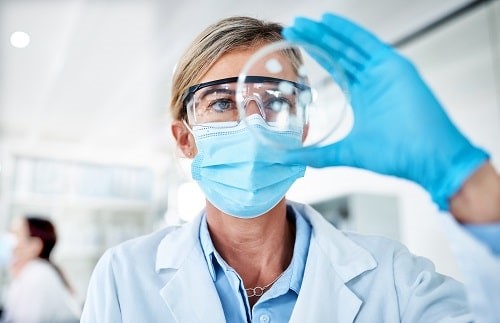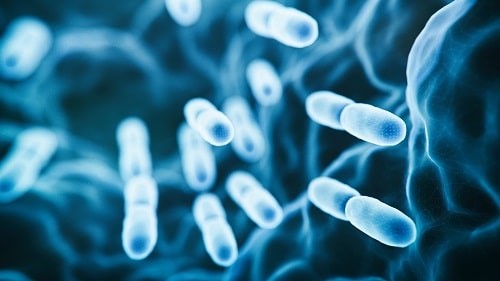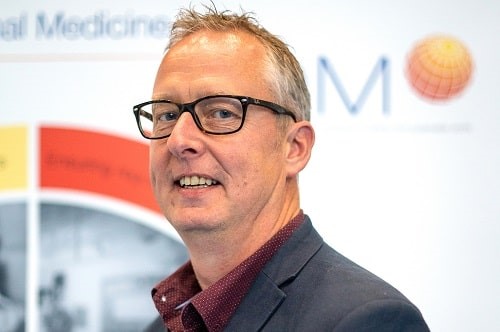Microorganisms like bacteria, viruses and mould can pose a significant risk to the health of workers and the public, so it’s essential that duty holders take appropriate steps to prevent their spread, such as good ventilation and regular testing and analysis to identify and monitor their presence.
Features
Microbiological contamination: time to act
Microorganisms in the air, such as bacteria, viruses and fungi, can pose significant risks to human health and the environment. Once airborne, microorganisms, collectively known as microbes, can cause or aggravate serious and sometimes fatal health conditions, such as allergies, asthma, respiratory infections and respiratory diseases.
Microorganisms can also permeate substances like food and water, posing further risks to human health. For example, legionella bacteria in water systems in buildings poses a risk of people contracting Legionnaires’ disease.
The rise in antimicrobial resistance – when microorganisms like bacteria and viruses change over time and no longer respond to medicines – make infections harder to treat and increase the risk of disease spreading. This means it is vital that employers understand the hazards posed by microbiological contamination and implement effective measures to protect worker and public health and the environment.
So, where does microbiological contamination commonly occur in workplaces and public buildings? What can employers and those in charge of these environments do? How can the risk it poses to human health be minimised if it does occur?
 Microorganisms like bacteria, viruses and mould can pose a significant risk to the health of workers and the public, so it’s essential that duty holders take appropriate steps to prevent their spread. Photograph: iStock
Microorganisms like bacteria, viruses and mould can pose a significant risk to the health of workers and the public, so it’s essential that duty holders take appropriate steps to prevent their spread. Photograph: iStock
Where microbiological contamination occurs
Microbiological contamination can occur in a number of industries, for example:
Construction and retrofit
During a construction or retrofit project, dust, and the disturbing of old and degraded materials such as carpets, furnishings, and cardboard, can potentially expose workers and building occupants to harmful microorganisms, especially if materials are hygroscopic or wet.
Large numbers of fungal and bacterial species can be found in indoor environments, such as Fungi, mainly Cladosporium spp, Penicilium spp, Aspergillus spp, Stachybotrys chartarum; and bacteria, mainly large groups of Gram-negative bacteria and mycobacteria. These are all microorganisms commonly found inside dwellings and other buildings. The risk of exposure can arise from work activities and situations like rainwater penetrations, water leaks, contact with sewage and poor ventilation.
Warmth and humidity also promote the growth of microorganisms, further increasing the risk to the health of workers and site occupants from these biologically hazardous contaminants.
Manufacturing and processing
The combination of raw materials, water, processes and facility design can result in human exposure to microbiological contamination, particularly in an unclean and poorly managed environment. A common example is legionella from poorly managed water systems.
Waste processing and treatment
Throughout the various stages of waste collection, transportation and treatment (including municipal waste from households and waste from business activities like construction), microorganisms grow due to the optimal conditions.
Microbiological growth is particularly rapid from food waste and composting organic waste, such as grass cuttings and agricultural waste. Therefore, workers who handle waste materials can be exposed to aerobic bacteria in both indoor and outdoor environments, such as in waste processing plants and landfill sites.
Offices
In an office environment, particularly new-builds, one of the main concerns is indoor air quality and the potential for airborne pathogen contamination leading to (or being associated with) what is commonly known as Sick Building Syndrome.
Sick building syndrome is characterised by a number of symptoms among some or all of the building’s occupants, such as headaches, dry and sore eyes and throats, a runny nose, dry skin and difficulty concentrating. Although it is not clear exactly what causes sick building syndrome, it sometimes occurs when a building is airtight, has inadequate ventilation or has a poorly maintained air conditioning and ventilation system.
 Frequent monitoring and inspection of environments will help to identify microbiological hazards at the earliest stage. Photograph: iStock
Frequent monitoring and inspection of environments will help to identify microbiological hazards at the earliest stage. Photograph: iStockThere is also evidence that the problem can be exacerbated in the winter by central heating. The quality of outdoor air – in other words, if the building is in a heavily built-up area with high pollution levels – also impacts on the indoor environment.
Also, in many office environments, there will be a high number of staff working in confined areas, and this poses a greater risk of cross contamination from poor hygiene, food handling and poor sanitation. The presence of unclean surfaces and shared equipment means bacteria and viruses can transmit readily, causing illness, such as colds and viruses and more recently the spread of SARS‑CoV‑2 (Covid-19).
Agriculture and soil
Microbiological contamination occurs in soil due to a variety of sources, including untreated manure and wastewater, animal faecal matter and insect debris and by-products. The moist optimal conditions for growth mean that free-living microorganisms survive for prolonged periods, which in turn can have a negative impact on public health, especially for those with underlying health conditions.
For example, inhaling Aspergillus Fumigatus spores – which are naturally present in soil, compost and rotting leaves – can cause Aspergillosis, which causes breathing difficulties and exacerbates lung problems in vulnerable individuals, such as those a weakened immune system and lung conditions like chronic obstructive pulmonary disease (COPD).
What does the law say about preventing microbiological contamination?
Both the Health and Safety at Work Act 1974 and the Control of Substances Hazardous to Health Regulations 2002 (COSHH) make it clear that employers have a duty to take all reasonably practicable measures to protect the health, safety and welfare of their employees, the public and the environment. This includes taking all reasonably practicable steps to protecting workers and others (such as the public) from the risk of ill health from microorganisms.
To reduce the risk of workers and building occupants being exposed to airborne contaminants like bacteria, viruses and fungi, employers need to ensure there is adequate ventilation in buildings and seek to improve indoor air quality. Guidance on how to improve ventilation and indoor air quality can be found on the Health and Safety Executive’s website under ‘ventilation in the workplace’, in guidance from the Chartered Institution of Building Services Engineers (CIBSE) and in the Building Regulations Part F.
How can organisations prevent microbiological contamination?
Occupational hygienists and microbiologists offer a range of services designed to help organisations identify and reduce human exposure to contaminants such as bacteria, bio-aerosols and mould.
For instance, IOM’s new Microbiological Laboratory Service can accurately sample and analyse air, liquid and solid samples to identify the type and sources of biologically hazardous contaminants and assess the level of risk they pose. The experts can then advise employers on the appropriate steps to take to minimise the health risks from microorganisms found in their buildings, work processes and public environments.
 David R Flower will be speaking at the SHW Live exhibition in Farnborough on 27-28 September on ‘Microbiological Contamination, the Hazards and the Solutions’.
David R Flower will be speaking at the SHW Live exhibition in Farnborough on 27-28 September on ‘Microbiological Contamination, the Hazards and the Solutions’.
Five steps employers can take to reduce the health risks from microorganisms are:
1. Good housekeeping practices: these are essential in preventing contamination. They include maintaining clean facilities, frequent sanitisation of equipment and training employees on good hygiene practices.
2. Inspection and monitoring: frequent monitoring and inspection of environments will help to identify microbiological hazards at the earliest stage and allow action to be taken to reduce the risk they pose.
This is particularly important in high-risk environments, such as waste processing facilities and where monitoring and treatment of water systems are vital in preventing the growth of bacteria like legionella, such as in hospitals and factories. A professional occupational hygienist can help the duty holder to assess the risks from microorganisms.
They can also conduct air sampling to assess the level of environmental contaminants, identify the people who are most at risk of exposure to the microorganisms and advise on appropriate corrective actions in line with the recognised hierarchy of control.
3. Suitable waste management: correct disposal of waste and debris will minimise the risk of microbiological contamination, especially if the waste contains fluids, solids and materials that could potentially carry and transfer microorganisms.
4. Adequate ventilation: with the average person spending around 80 per cent of their time indoors, it is essential to prevent the build-up of moisture in the internal environment as moisture creates the perfect breeding ground for microorganisms to grow. Employers should consider installing (and properly maintaining) suitable air filtration and ventilation systems as these will help remove all harmful particles from the air. Air quality sensors can also be used to help identify if conditions are likely to result in biological contamination in internal environments
5. Personal protective equipment, including respiratory protective equipment: this is critical to prevent those handling materials that may be contaminated with microorganisms from being directly exposed to the substances. Staff should also be educated and trained on how to avoid exposure to microorganisms.
Microbiological contamination is understandably a significant concern for a wide variety of industries and the public. It is therefore vital that employers improve their awareness of the risks it poses to human health, and consider taking approaches such as professional sampling, testing and analysis to ensure that workplaces remain safe for all.
David R Flower will be speaking at the SHW Live exhibition in Farnborough on 27-28 September on ‘Microbiological Contamination, the Hazards and the Solutions’. IOM will also be exhibiting on Stand 124. See: safetyhealthwellbeing.live
For more information see:
iom-world.org/lab-services
David R Flower is Senior Occupational Hygienist at the Institute of Occupational Medicine (IOM)
FEATURES

Sedentary working and how to combat the ‘sitting disease’
By Gavin Bradley, Active Working on 05 April 2024
Prolonged and excessive sitting poses a major risk to our health, but the Get Britain Standing campaign and On Your Feet Britain Day on 25 April are a great way of encouraging workers to sit less and move more.

Company culture and wellbeing: a crucial link
By Bex Moorhouse, Invigorate Spaces on 05 April 2024
Investing in measures to support worker wellbeing will be ineffective unless the company culture genuinely incorporates values like teamwork, involvement, flexibility and innovation.

Office design and culture: happier and healthier staff – or the opposite?
By Guy Osmond, Osmond Ergonomics on 03 April 2024
Applying ergonomic principles to workstation set-ups and ensuring the physical environment supports neurodivergent people are just some of the ways of creating an office where everyone can thrive, but a supportive and positive organisational culture is vital too.


